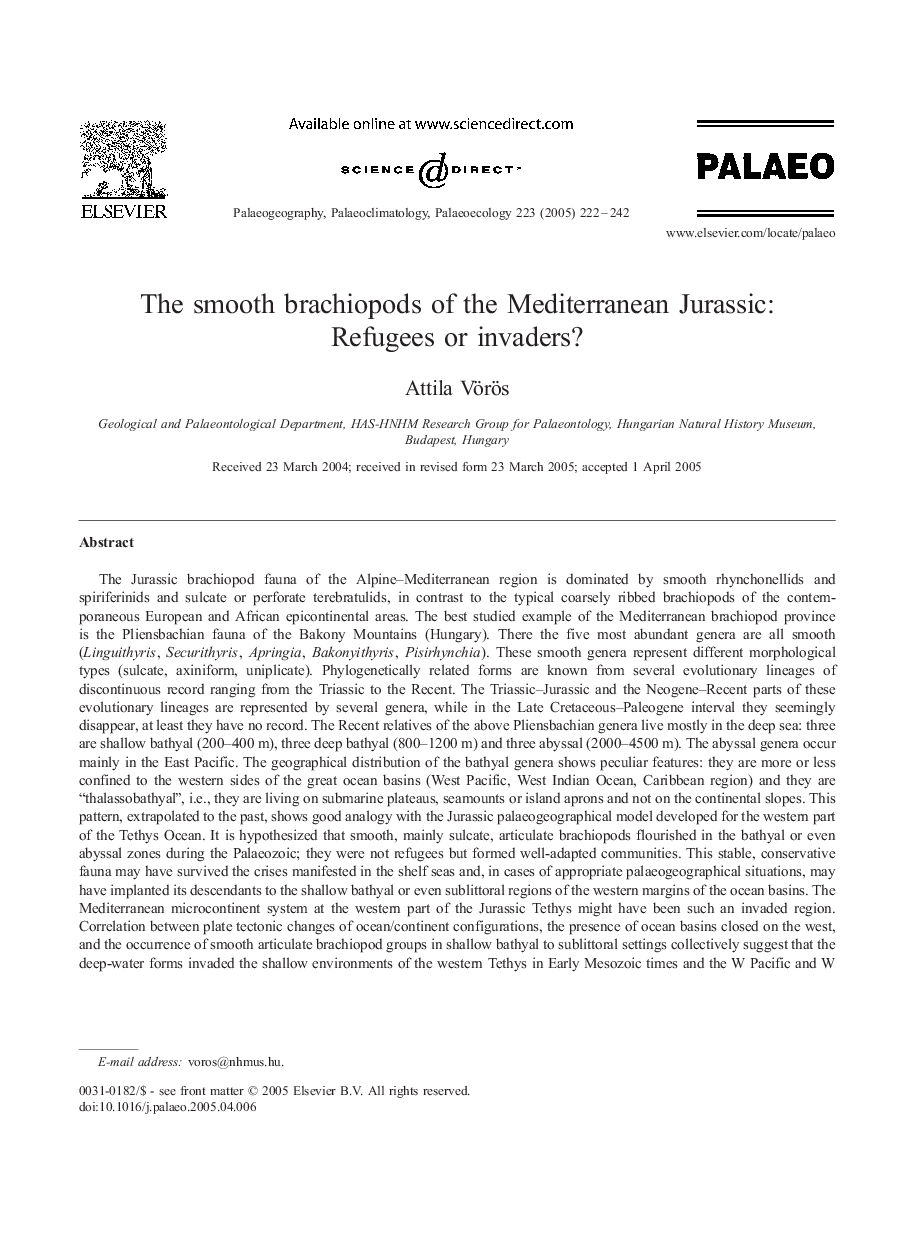| کد مقاله | کد نشریه | سال انتشار | مقاله انگلیسی | نسخه تمام متن |
|---|---|---|---|---|
| 9462975 | 1622390 | 2005 | 21 صفحه PDF | دانلود رایگان |
عنوان انگلیسی مقاله ISI
The smooth brachiopods of the Mediterranean Jurassic: Refugees or invaders?
دانلود مقاله + سفارش ترجمه
دانلود مقاله ISI انگلیسی
رایگان برای ایرانیان
کلمات کلیدی
موضوعات مرتبط
مهندسی و علوم پایه
علوم زمین و سیارات
فرآیندهای سطح زمین
پیش نمایش صفحه اول مقاله

چکیده انگلیسی
The Jurassic brachiopod fauna of the Alpine-Mediterranean region is dominated by smooth rhynchonellids and spiriferinids and sulcate or perforate terebratulids, in contrast to the typical coarsely ribbed brachiopods of the contemporaneous European and African epicontinental areas. The best studied example of the Mediterranean brachiopod province is the Pliensbachian fauna of the Bakony Mountains (Hungary). There the five most abundant genera are all smooth (Linguithyris, Securithyris, Apringia, Bakonyithyris, Pisirhynchia). These smooth genera represent different morphological types (sulcate, axiniform, uniplicate). Phylogenetically related forms are known from several evolutionary lineages of discontinuous record ranging from the Triassic to the Recent. The Triassic-Jurassic and the Neogene-Recent parts of these evolutionary lineages are represented by several genera, while in the Late Cretaceous-Paleogene interval they seemingly disappear, at least they have no record. The Recent relatives of the above Pliensbachian genera live mostly in the deep sea: three are shallow bathyal (200-400 m), three deep bathyal (800-1200 m) and three abyssal (2000-4500 m). The abyssal genera occur mainly in the East Pacific. The geographical distribution of the bathyal genera shows peculiar features: they are more or less confined to the western sides of the great ocean basins (West Pacific, West Indian Ocean, Caribbean region) and they are “thalassobathyal”, i.e., they are living on submarine plateaus, seamounts or island aprons and not on the continental slopes. This pattern, extrapolated to the past, shows good analogy with the Jurassic palaeogeographical model developed for the western part of the Tethys Ocean. It is hypothesized that smooth, mainly sulcate, articulate brachiopods flourished in the bathyal or even abyssal zones during the Palaeozoic; they were not refugees but formed well-adapted communities. This stable, conservative fauna may have survived the crises manifested in the shelf seas and, in cases of appropriate palaeogeographical situations, may have implanted its descendants to the shallow bathyal or even sublittoral regions of the western margins of the ocean basins. The Mediterranean microcontinent system at the western part of the Jurassic Tethys might have been such an invaded region. Correlation between plate tectonic changes of ocean/continent configurations, the presence of ocean basins closed on the west, and the occurrence of smooth articulate brachiopod groups in shallow bathyal to sublittoral settings collectively suggest that the deep-water forms invaded the shallow environments of the western Tethys in Early Mesozoic times and the W Pacific and W Indian Oceans in the Neogene. They stayed in the deep-sea reservoir when a circum-equatorial ocean existed in the Late Mesozoic.
ناشر
Database: Elsevier - ScienceDirect (ساینس دایرکت)
Journal: Palaeogeography, Palaeoclimatology, Palaeoecology - Volume 223, Issues 3â4, 1 August 2005, Pages 222-242
Journal: Palaeogeography, Palaeoclimatology, Palaeoecology - Volume 223, Issues 3â4, 1 August 2005, Pages 222-242
نویسندگان
Attila Vörös,